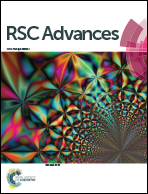Synthesis, structure, electrochemical, DNA interaction and antimicrobial studies of fluorinated trans-dicationic pyridinium porphyrins†
Abstract
A series of trans-pyridyl porphyrins, 5,15-di(pentafluorophenyl)-10,20-bis(2′/3′/4′-pyridyl)porphyrin (1–3), trans-dicationic pyridinium porphyrins, 5,15-di(pentafluorophenyl)-10,20-bis(2′/3′/4′-N-methylpyridyl)porphyrins (4–6) and their copper(II) and zinc(II) derivatives were synthesized. These compounds were characterized using various spectroscopic methods, electrochemical and single crystal X-ray crystallographic studies. The trans-dicationic porphyrin derivatives exhibit red shifted absorption spectra over the simple pyridyl porphyrins. The reduction potentials of trans-pyridyl porphyrins are more positive than those of MTPPs. Crystal structure of 3c is forming networks of molecules through Zn–N coordination displaying large number of channels. The intermolecular interactions involving fluorine contributes considerably to the crystal packing in all the structures which was confirmed by computational Hirshfeld surface analysis. The dicationic porphyrins were further explored for its DNA interaction abilities and antimicrobial activities. The UV-visible and fluorescence spectroscopic titrations indicate that the porphyrins bind with the calf thymus DNA by outside groove binding mode with or without self-stacking. The intrinsic binding constants Kb of these dicationic porphyrins to DNA was found to be in the range of 105 to 106 M−1. The results reveal that among the three sets of porphyrins (4–6), the 3-/4-pyridyl derivatives display higher DNA binding activities compared to the 2-pyridyl analogues. The photocleavage experiments disclose that the porphyrins employ 1O2-mediated mechanism in cleaving DNA and the freebase and zinc(II) derivatives show better photoinduced cleavage ability compared to its copper(II) analogues. The dicationic porphyrins also show significant antimicrobial activities than those of non-fluorinated analogues.


 Please wait while we load your content...
Please wait while we load your content...